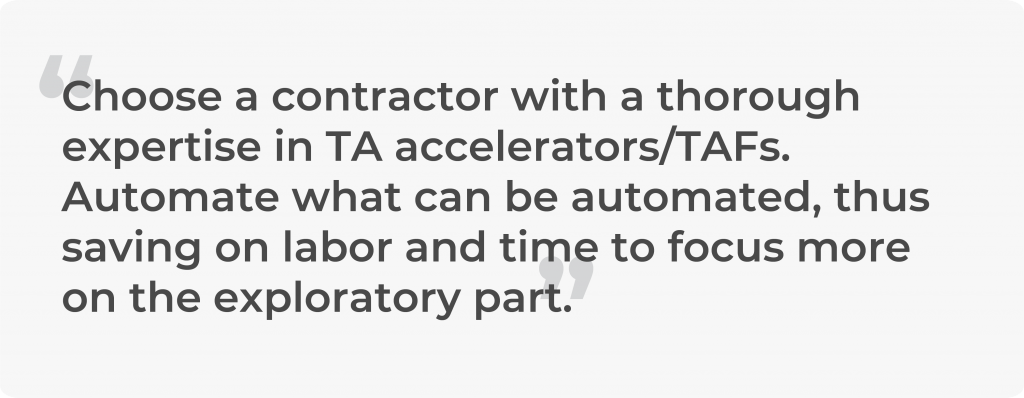The quicker, the better, - that's what a client wishes. Speedy delivery and high quality is what our automation engineers provide. How Qulix Systems ensures efficiency without compromising on overall performance? Learn about the tips on how to accelerate and automate your QA procedures from our article below.
written by:
Anton Rykov
Product Manager, Qulix Systems
The quicker, the better, - that's what a client wishes. Speedy delivery and high quality is what our automation engineers provide. How Qulix Systems ensures efficiency without compromising on overall performance? Learn about the tips on how to accelerate and automate your QA procedures from our article below.
An after-release feedback gives rise to meaningful product changes and may significantly alter the development path. However, for the feedback to gain maximum effect, it should be diversified and quick, as though the whole production cycle went live and public. Ideally, the product literally sucks public commentary and evolves on the go. So, how can a product owner collect public response and enact meaningful changes in almost no time? Among other things, it is through efficient QA-procedures and namely, test automation.
QA automation allows for wide test coverage, cuts manual labor, and eliminates the human factor, thus ensuring a more prompt product delivery. As if it wasn’t enough, pro-active QA companies further speed up automation by using Test Automation Frameworks.
Test Automation Framework, the first joker of a QA-company
TAF is a set of libraries, modules along with standards and principles of work. Rather than being an actual component of a testing software application, the test automation framework is a combination of concepts and tools that works with items like internal libraries and reusable code modules to provide a foundation for test automation.
Оnce in action, a customized Test Automation Framework ensures multiple benefits for the client. A product-specific Test Automation Framework is:
- Business domain oriented [e.g. banking, finances, healthcare, etc.]
- Application domain oriented [integrates application-specific components]
- Process-based [integrates process and procedures typical for a given client]
- Well-integrated [enables test management, reporting, emailing]
- Constitutes a contractor’s QA culture/guidelines [a deep domain expertise accumulated throughout the years of work].
As it happens, a Test Automation Framework generates numerous benefits for the team of testing engineers too. When time is money, Test Automation Framework in place cuts time the team spends on scripts writing. Secondly, it facilitates scripts maintenance. Thirdly, due to its high maturity overall transparency of the testing processes increases. To sum it up, in terms of code writing, using Test Automation Framework enhances code reusability, stability, and maintainability.
Finally, TAF facilitates onboarding for newcomers and cushions the impact of a personnel turnover.
All in all, a product-specific Test Automation Framework enables testing engineers to triple their output. Alongside this, it allows leveraging the benefits of costly automated testing more effectively.
Not bad, isn’t it? Where’s the catch?
Truth be told, the market today is pretty saturated with test automation frameworks, from commercial to open source ones. The stumbling stone of them all, however, regardless the type, is a steep learning curve and the difficulty the teams experience tailoring them to meet the requirements of a specific automation project.
Say, open source TAFs are available free of charge and some of them even promise you won’t need to bother much about code writing. They really can become magic wands in the hands of a true master and we don’t deny that, as Qulix Systems itself uses Selenium. Nevertheless, beware of easy solutions. The more you expect from your TAF to do, the more you invest in it. At this point, an estimated QA company lays its joker on the table which is a thorough expertise. In terms of code lines, yeah, there will be hundreds before a framework will start working miracles. And it is namely competence that allows companies build a Test Automation Framework that works, brick by brick, through trial and error.
The second joker peeks out from the pocket
While Test Automation Framework facilitates automated testing procedures, it is still time and effort-consuming to build and deploy.
It all starts from selecting appropriate tools and building a technology stack followed by the designing stage. What comes next, when time comes to lay the ground, depends on the competence once again. Either a company has the knowledge how to do things quickly and efficiently, or not. In the first Quickly-and-Efficiently Scenario, once framework’s design is ready, test automation accelerators kick in.
Automation accelerators, what are they? These are reusable modules that form a product-independent basic framework to be further extended into a product-specific TAF. Leveraging accelerators is crucial for a quick start of the test automation (TA) project as they eliminate a good deal of preparatory work. More often than not, TA initialization implies performing industry-agnostic repetitive procedures almost identical from product to product. Accelerators seamlessly integrate into the product-specific TAF thus enabling quick start of active testing.
However, deploying accelerators is more than simply cropping out a few lines from a long-running list of test procedures. See more benefits in detail in the list below.
Reusability is an unquestionable killer as far as implementing accelerators is concerned. Pre-built function libraries fit numerous projects, thus saving a client on test development cost as the same script runs repeatedly.
Another plus of the accelerators, is that they can be technology agnostic. Ideally, the client leverages multiple tools and technologies, including open source ones, which significantly decreases his/her production expenditures.
As long as maintenance is ensured, the script will serve TA team well. However, maintenance demands effort from testing engineers and drains client’s budget massively over time adding up to the total cost of production. Yet when maintenance is done on a regular basis as part of deploying accelerators, the overall cost of maintenance drops due to frequent releases and the process itself becomes more flexible.
Deploying automation accelerator equals faster time to market and higher ROI which is crucial for any business investment.
The last, but not least: in numerical terms, in five to ten test cycles the TA project reaches its break-even point.
Thus, automation testing accelerators that Qulix Systems leverages in its work facilitate/speed up automation testing of Web/Mobile GUI, FTP, SMTP/POP3/IMAP using Selenium plus Java. According to Alexey Rakitsky, Test Automation Manager, QA Services at Qulix Systems, using accelerators saves the client up to 70-80 percent of TA initiation costs. Along with that, deploying reliable accelerators cuts developers’ involvement on the project by 15-20 percent, which also makes costly automation testing more budget-friendly.
Do not forget to remember that…
Firstly: deploying a TAF is mostly typical for a long-term project, where the client reasonably opts for automated testing to reduce manual efforts/eliminate human factor/speed up testing or all at once.
Secondly: you may at all be hesitant whether automation testing is what your project needs. In such a case, we recommend launching a Proof-of-Concept project. Hence, after such a feasibility study the client is equipped with adequate understanding of test automation benefits and implications.
Thirdly: If PoCP consequentially results in test automation deploying, choose a contractor with a thorough expertise in test automation accelerators/TAFs. Automate what can be automated, thus saving on labor and time to focus more on the exploratory part.
This article was wrtitten in close collaboration with Alexey Rakitsky, Test Automation Manager, QA Services.
Need assistance in combating defect leakage or consulting for robust and regular defect monitoring? Contact our Support team or visit our website. Qulix Systems is renown for its QA services and pays immense attention to the professional advancement of its testing engineers.

Contacts
Feel free to get in touch with us! Use this contact form for an ASAP response.
Call us at +44 151 528 8015
E-mail us at request@qulix.com








